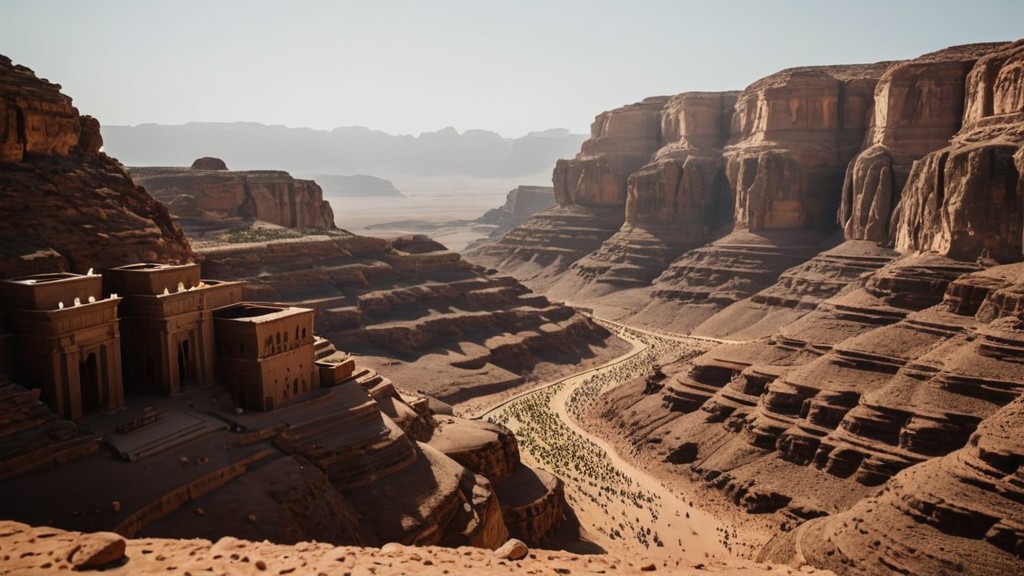The Arabian Peninsula
The Arabian Peninsula

The Arabian Peninsula, often shrouded in mystery and allure, has been a critical crossroads for trade and culture for millennia. At the heart of this historic landscape lies the Incense Route, a network of trade paths that facilitated the movement of valuable commodities such as frankincense and myrrh between the East and West. This route not only transformed regional economies but also fostered cultural exchanges that have shaped the identities of the civilizations in the region. Key locations along the route, such as Petra in Jordan and Madain Saleh in Saudi Arabia, serve as poignant reminders of the sophisticated trade networks that once thrived in this arid yet vibrant land.
The Incense Route: An Overview
The Incense Route was vital for the transportation of fragrant resins harvested from trees found primarily in the southern Arabian Peninsula. These products were highly sought after in ancient markets, particularly in Egypt, Greece, and Rome, where they were used for religious rituals, perfumery, and medicine. The route's prominence can be traced back to around the 7th century BCE and lasted over a millennium, with caravans transporting goods across vast deserts and mountainous terrain.
The Geography of the Route
The Incense Route comprised various branches, each linking important cities and trading posts. Caravans often traversed routes through the mountains of Yemen, across the deserts of central Arabia, and into the Levant. The most notable cities along the route include: The Arabian Peninsula
- Petra (Jordan): Once the bustling capital of the Nabataean Kingdom, Petra was a crucial stop for traders. Its strategic location allowed for the collection and redistribution of goods across the Mediterranean and beyond.
- Madain Saleh (Saudi Arabia): This remarkable archaeological site, known for its well-preserved tombs cut into rock formations, served as another key trading hub, facilitating commerce between the Arabian interior and the Levant.
Other important locations included Saba (in modern-day Yemen), Dedan, and Tayma, which provided vital oases for travelers and merchants.
Petra: The Rose-Red City
Historical Significance
Petra, often referred to as the Rose-Red City, embodies the peak of Nabataean ingenuity. The Nabataeans, a nomadic tribe, settled in this area around the 4th century BCE, turning Petra into a flourishing center for trade. The intricate water management systems they developed allowed them to thrive in this arid region, enabling agriculture and supporting a growing population.The Arabian Peninsula
The architectural marvels of Petra, including the Treasury and the Monastery, showcase the blending of various cultural influences from the Hellenistic, Roman, and Arabian worlds. These remarkable structures were not merely works of art; they were also functional trade hubs, designed to facilitate the commerce that flowed through this vital city.
Cultural Exchange The Arabian Peninsula
Petra was not only a commercial center but also a melting pot of cultures. As traders from different regions converged here, they exchanged ideas, beliefs, and practices. The presence of Greek, Roman, Egyptian, and local Nabataean influences can be seen in Petra’s artifacts and architectural styles. This blend enriched the local culture, making Petra a vibrant center of commerce and creativity. The Arabian Peninsula
For more information on Petra’s history and its significance, visit: UNESCO World Heritage site: Petra.
Madain Saleh: Arabia's Hidden Gem

Historical Context
Also known as Al-Hijr, Madain Saleh became the first UNESCO World Heritage site in Saudi Arabia in 2008. The site features over 130 rock-cut tombs, showcasing the architectural brilliance of the Nabataeans. It served as a significant settlement for caravan traders and was heavily influenced by the thriving trade in incense and spices.
The archaeological findings in Madain Saleh reveal a society that was affluent and culturally sophisticated. Carvings and inscriptions found in the tombs provide insights into the lives of the people who once inhabited this region, including their beliefs and customs.
Impact on Trade and Culture
The strategic location of Madain Saleh allowed it to play a pivotal role in the caravan trade, linking the incense supply from southern Arabia to the markets of the Roman Empire. This connection brought wealth, culture, and innovation to the region, allowing Madain Saleh to flourish as a trade hub.
Much like Petra, Madain Saleh served as a point of cultural exchange. With traders coming from as far as the Mediterranean and East Africa, the site became a melting pot of languages, religions, and customs. The influence of these interactions can still be traced in the cultural fabric of modern Saudi Arabia. The Arabian Peninsula
For additional details about Madain Saleh, check out: Madain Saleh at Saudi Tourism.
The Decline of the Incense Route
Despite its initial success, the Incense Route began to decline around the 3rd century CE due to several factors, including the rise of maritime trade routes and the development of alternative land paths. The emergence of new trading powers, such as the Romans and later the Byzantines, further diminished the significance of the land routes.
The decline of the Incense Route also coincided with changes in the production and use of incense, as other forms of fragrance and new cultural practices emerged. Eventually, the once-bustling trade centers of Petra and Madain Saleh fell into decline, becoming forgotten relics of a past era.
Legacy and Cultural Impact
Today, the remnants of the Incense Route serve as a reminder of Arabia's rich history of trade and cultural interchange. The architectural wonders of Petra and Madain Saleh attract tourists and scholars alike, keen to uncover the secrets of this ancient world.
Moreover, the historical significance of the Incense Route continues to influence modern Arabian identity. The blend of cultures experienced in these trade hubs has contributed to the diverse and rich heritage of the region, showcasing how trade can shape societies across time and space.
By celebrating and studying these historical routes and cities, we gain insights into the dynamics of trade, culture, and cooperation that defined ancient Arabia, fostering appreciation for the intricate tapestry of human history that continues to this day.
Conclusion
The ancient Incense Route was more than just a trade path; it was a vital artery of cultural exchange that connected peoples and places across the Arabian Peninsula and beyond. Locations like Petra and Madain Saleh stand as testaments to the sophisticated civilizations that thrived along these routes, their legacies continuing to influence trade and culture today. As we unveil the secrets of Arabia's ancient trade routes, we not only understand the past but also recognize the enduring connections that shape our present.
